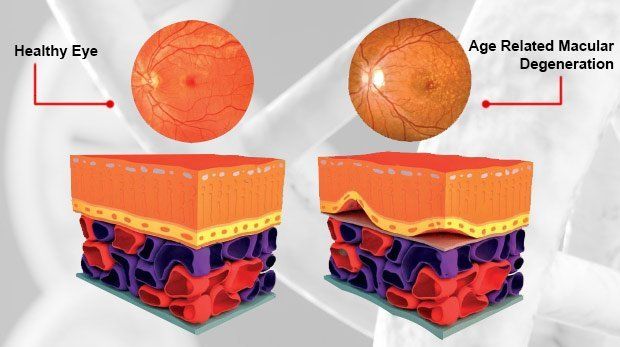AGE RELATED MACULAR DEGENERATION DIAGNOSIS AND TREATMENT

What is AMD?
AMD is a common eye condition and a leading cause of vision loss among people age 50 and older. It causes damage to the macula, a small spot near the center of the retina and the part of the eye needed for sharp, central vision, which lets us see objects that are straight ahead.
AMD by itself does not lead to complete blindness, with no ability to see. However, the loss of central vision in AMD can interfere with simple everyday activities, such as the ability to see faces, drive, read, write, or do close work, such as cooking or fixing things around the house.
The Macula
The macula is made up of millions of light-sensing cells that provide sharp, central vision. It is the most sensitive part of the retina, which is located at the back of the eye. The retina turns light into electrical signals and then sends these electrical signals through the optic nerve to the brain, where they are translated into the images we see. When the macula is damaged, the center of your field of view may appear blurry, distorted, or dark.
Dr. Selina McGee describes Macular Degeneration and the advance medical imaging technology her office uses to help catch the disease as early as possible.
Schedule an eye exam
Who is at risk for AMD?
Smoking. Research shows that smoking doubles the risk of AMD.
Race. AMD is more common among Caucasians than among African-Americans or Hispanics/Latinos.
Family history and genetics. People with a family history of AMD are at higher risk. At last count, researchers had identified nearly 20 genes that can affect the risk of developing AMD. Many more genetic risk factors are suspected.
Does lifestyle impact AMD?
Avoid smoking
Exercise regularly
Eat a healthy diet rich in green, leafy vegetables and fish (omega 3's)
What are the stages of AMD?
Early AMD . Early AMD is diagnosed by the presence of medium-sized drusen, which are about the width of an average human hair. People with early AMD typically do not have vision loss.
- In geographic atrophy (also called dry AMD), there is a gradual breakdown of the light-sensitive cells in the macula that convey visual information to the brain, and of the supporting tissue beneath the macula.
These changes cause vision loss.
- In neovascular AMD (also called wet AMD), abnormal blood vessels grow underneath the retina. (“Neovascular” literally means “new vessels.”) These vessels can leak fluid and blood, which may lead to swelling and damage of the macula. The damage may be rapid and severe, unlike the more gradual course of geographic atrophy. It is possible to have both geographic atrophy and neovascular AMD in the same eye, and either condition can appear first.
Not everyone with early AMD will develop late AMD. For people who have early AMD in one eye and no signs of AMD in the other eye, about 5% will develop advanced AMD after 10 years. For people who have early AMD in both eyes, about 14% will develop late AMD in at least one eye after 10 years. With prompt detection of AMD, there are steps you can take to further reduce your risk of vision loss from late AMD.
Nutrition and AMD
Stop smoking
Eat your green leafy vegetables
Take eye nutrition supplements that include a balanced ratio of 10mg of Lutein and 2 mg Zeaxanthin



